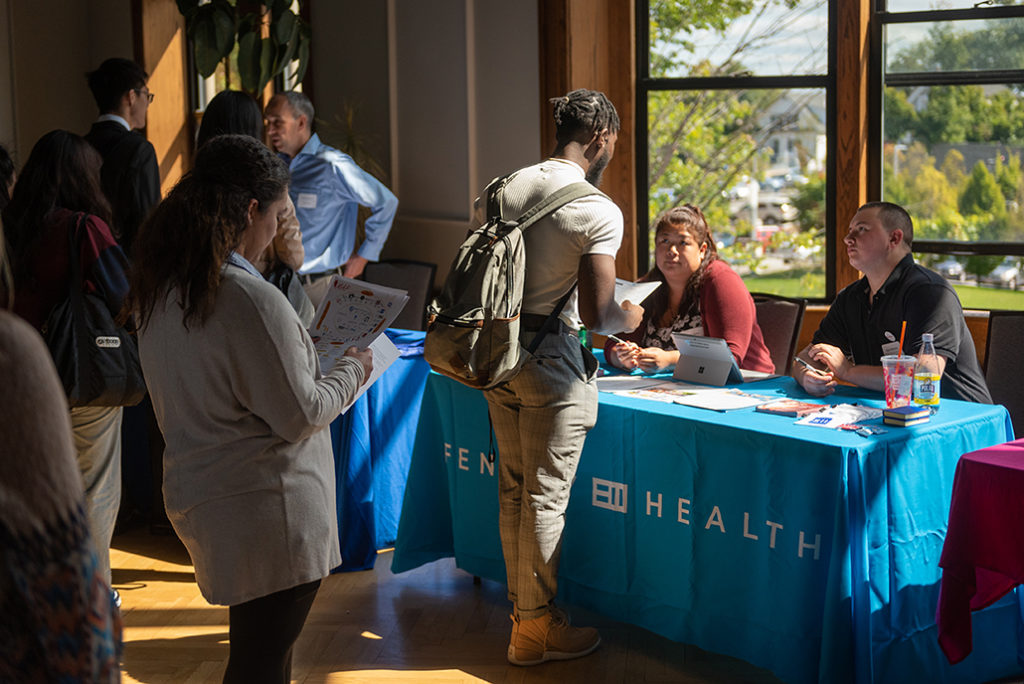#ClarkTogether
Workplace diversity experts provide virtual guidance to students seeking jobs, internships

Clark students who are searching for internships or jobs want to know that their potential employers are embracing diversity, equity, and inclusion throughout their organizations. In an Oct. 15 webinar hosted by the Career Connections Center, four panelists from a range of industries provided insight and guidance about how job seekers can ensure that a company truly “walks the walk” when it comes to diversity.
Diversity should permeate every facet of an organization, said Ayana Pilgrim-Brown ’00, manager of diversity recruitment strategy at The Vanguard Group. “Companies are now being called out on that,” she explained. People are looking to see if organizations are simply “joining the hashtag” or are making systemic changes in their structures, including on their boards of directors.
To determine if a potential employer offers an inclusive workplace, take a look at their website and marketing materials, suggested Ildemaro Gonzalez, vice president and chief inclusion and diversity officer at Dana-Farber Cancer Institute. “If you see diversity and inclusion reflected in an organization’s priorities, that’s a good sign.”
There is another way to find out if a company embraces diversity: Ask them. Grace Moreno, executive director of the Massachusetts LGBT Chamber of Commerce, urged job seekers to ask recruiters and interviewers questions. “It matters to this generation,” she said. Job seekers have the right to ask why a company has only white men on its board of directors, or how it supports staff of color, LGBTQ employees, and anti-racism efforts within its workforce. “Companies that are walking the walk will appreciate that.”
Rodney Marshall, programs manager in the Office of Diversity and Inclusion Services at the American Red Cross, said that job seekers should ask specifically how diversity and inclusion is woven throughout the organization, including programs and resources. If the workplace is not diverse, what are they doing to change that?
Organizational diversity and inclusion is mission-critical for companies, especially in times of crisis, said Pilgrim-Brown. Many companies made bold statements after the police killing of George Floyd in May — but have those statements been followed by action? Inclusivity involves systemic changes and cultural changes that take time, she noted.
During their discussion, the panelists addressed the concerns of students who might feel targeted and tokenized by diversity recruitment programs.
Gonzalez encouraged students to try to change their perceptions. “These programs exist to recruit diverse employees — that’s it,” he said. “Try to think about how those programs can benefit you and how you can share your talents.”
Marshall agreed. “Diverse employees have value. Understand your value, and recognize what you bring to the organization.”
Pilgrim-Brown noted that diversity recruitment programs are used because employers feel there is a gap in the diverse-talent pipeline. “We have an obligation to find ways to fill that gap.”
But those programs should be followed by institutionalized support for the employees who are hired, Gonzales said. If that happens, the organization truly is trying to weave inclusion through its culture.
Pilgrim-Brown encouraged students to share their passions when they interview for a position. “If climate change is important to you, or giving back to poor communities, ask what the company is doing to contribute in those areas.”
Moreno agreed. “The right company will see your enthusiasm and understand that you want to do something — companies want passionate people.”
This webinar was just one way the Career Connections Center helped students prepare for our recent Innovation, Impact & Inclusion Virtual Career Fair. The Center can help you find a job or internship, connect with employers and alumni career professionals, work on your resume, practice your interview skills, obtain advice, research careers, and much more. #clarkconnectsyou


